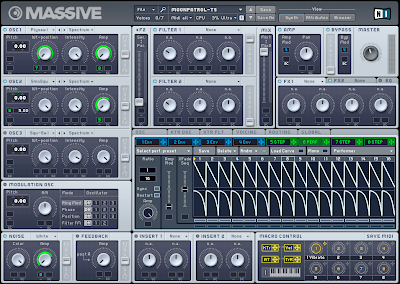 (Click the image above to enlarge.)
(Click the image above to enlarge.)Native Instruments Massive is an amazing synth. I'll admit, I wasn't sold when I first tried the demo, but once I got beyond the presets and started delving into programming it myself, I saw the light. I'm a modulation freak, and Massive is brimming with it. I especially find the Steppers and Performers to be a lot of fun, and used correctly, you can use them to make complete music arrangements (albeit simple ones).
Today, I'm going to show you how to use these modulators to make a little musical loop that sounds straight out of a 1980's arcade game.
1. Open up an instance of Massive and select File->New Sound to give you the init patch to start from.
2. On OSC1, select the Plysaw1 wavetable. If you play a few notes while fiddling with the WT-POSITION knob, you'll hear that it's a sawtooth wave that adds overtones and eventually, multiple harmonically related notes. We're going to use that characteristic to make a little melody.
3. Turn the AMP knob of OSC1 all the way down to zero. We're going to use a sequencer to control the volume automatically. Do this by heading down to the modulation section, clicking on one of the green square marked 8 LFO, and change it to a STEPPER using the little grey pulldown menu right below it. Make sure SYNC is selected, and that the stepper ratio is 1/16 for sixteenth notes. Use the RNDM menu to RANDOMIZE ALL to generate a random sequence. You can, of course, program the values manually as well. Now grab the modulation crosshairs (that cross-shaped icon next to the text in the green 8 STEPPER box) and drop it into the modulation slot under OSC1's AMP knob. Click and push up in the modulation slot to turn the amount of modulation all the way up.
4. Go ahead and turn OSC1's WT-POSITION knob all the way down and, in repeat the above process in the 7 LFO slot. Drag the modulation crosshairs from here to the modulation slot for OSC1's WT-POSITION. You should now here a cheesy little melody. Let's add some rhythm to it.
5. Turn on OSC2 and call up the SMOSQU wavetable. Use the 5 LFO slot to call up another stepper and program a sparse sequence. Just a trigger here and there. Drag the modulation crosshairs from 5 STEPPER to the slot under OSC2's AMP. Turn the AMP level here all the way down, and then increase the modulation amount to aabout 60%. This doesn't sound like much yet, but give me a second.
6. Go down and turn on the NOISE oscillator and select the WHITE noise type. Head on up to the 6 LFO slot and this time change it to PERFORMER. If you've never used it before, the PERFORMER is just like a fancier version of the STEPPER. It allows you to draw in different shapes for more complex modulations. It defaults to a simple, straight 16ths pattern which is perfect for what we need to do. Just make sure SYNC is selected and that the ratio is set to 1/16.
7. Now, drag modulation crosshairs to both the AMP level of the NOISE section (the AMP knob should be set at zero with modulation amount cranked all the way up), and to the PITCH modulation slot of OSC2 (with the pitch range set to 5.00). This turns OSC2 into the goofy sort of synth drums that were so prevalent in those games. If you've done everything right, you should have something that sounds like this:
This is really just the beginning. Want to add a little more authenticity? Call up a BITCRUSH effect on one of the inserts. And we haven't even turned on OSC3, so you can add still more complexity if you want. Have fun!
Download "MoonPatrol" patch for Massive.




















5 comments:
God I hated that game :(
I love Massive though! Thanks for the breakdown. More interactive that way than using the Tweakbench stuff!
Very very cool. I am just getting into massive and this has really shown me the flexibility. Thanks for a great tutorial.
Henry
Good tutorial, I like the resulting sound. Thanks!
Проститутки Питера старше 40 лет
Проститутки спб элитные
Дешевые проститутки Санкт Петербурга
Could you resend me the massive patch to my mail innervis.gs@gmail.com, great tut by the way!
Post a Comment